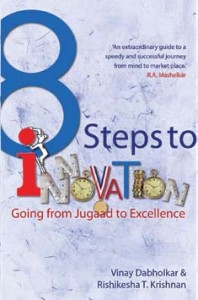 Readers interested in reading on innovation and leadership are spoilt for choice these days. It is a problem of plenty with very few books really contributing to the dialogue. Vinay Dabholkar, Rishikesha T Krishnan had to be innovative with their book on innovation to draw attention with their book ‘8 Steps to Innovation: From Jugaad to Excellence – A guide to systematic, as opposed to incidental, ad-hoc innovation.
Readers interested in reading on innovation and leadership are spoilt for choice these days. It is a problem of plenty with very few books really contributing to the dialogue. Vinay Dabholkar, Rishikesha T Krishnan had to be innovative with their book on innovation to draw attention with their book ‘8 Steps to Innovation: From Jugaad to Excellence – A guide to systematic, as opposed to incidental, ad-hoc innovation.
Innovation need not only be jugaad. For the first time a book shows us how in India, innovation can be introduced in ones organization in a systematic, deliberate way.
8 Steps to Innovation explains how you can do this by building an idea pipeline in your organization, improving the velocity of ideas coming in, and implementing the ideas within the given constraints. All this is shown through nice, snappy examples, mostly homegrown Indian ones. Few books in the market talk about innovation in the Indian context with Indian examples as this one does.
Anyone can innovate
 Ravi Venkatesan,
Ravi Venkatesan,
Former chairman of Microsoft India
It’s not a typical business book; a typical business book is written by someone who is infatuated by their own ideas. This one is so clearly written for practitioners. The way I describe this book as a tapestry of stories which illuminate the 8 step processes.
One of the most important thesis in this book is that there is room for optimism here. Anyone can innovate, regardless of age, education, innovation can happen in large, small organizations, in NGOs and even in Tihar Jail itself. It’s extraordinarily optimistic because if you read all the stories in the media you think of innovation as the privilege of the elite few like Steve Jobs, Bill Gates, Narayan Murthy, Ratan Tata and this is not for everyone. But they completely demolish this idea, story after story shows innovation happening, in the dingiest of shop floors, in ship yard in 19th century Scotland, Tihar Jail and Patna.
The ideas in this book really come into their own because the authors have really reached out to current thinking in entrepreneur management. Ideas such as the lean start up movement show how you can apply it in a variety of contexts.











Recent Comments